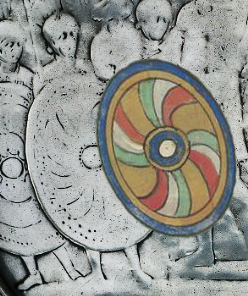
This page created 7 September 2014, and last modified: 20 December 2015 (incorrect pattern number fixed)

The Constantini Dafnenses is listed (18.23 in Ingo Maier's numbering scheme) as the twelth of the legiones comitatenses under the Magister Militum per Thracias. Its shield pattern (17#7) as shown in various manuscripts, under the matching label (17.g) Constantini Dafnenses, is as below:

The shield pattern has a double rim; the outer portion being variously depicted as being white (O), blue (P, M), red (W), or green (B), with the inner portion being yellow (blue in W). The boss has an outer white band (yellow in P), a blue middle band, and a white central dot (absent in M). The rest of the shield is a whirlygig design, with the arms trailing clockwise (but anticlockwise in B, which being printed, reverses the facings of all its shield patterns). There are sixteen arms, grouped into fours, coloured (clockwise) yellow, red, white, and green (O, P, M, except in M the green is faded to yellow); white, red, yellow, blue (W); and yellow, red (for two adjacent groups, white for the two others), green, red (B). Such a whirlygig pattern is unique in the Notitia, although that of the Prima Maximiana Thebaeorum (18.14, also under the Magister Militum per Thracias) is not so far removed, as it also shows a whirlygig, albeit with only four arms.
Interestingly, the Missorium of Valentinian, a silver plate depicting either Valentinian I or II with various soldiers/guards, and now held in the Museum of Art & History in Geneva, while worn with use, shows one man carrying a shield whose pattern looks very similar to that of the Constantini Dafnenses.

Here I have mirror-imaged the shield pattern, and stretched it to conform with the proportions of the shields carried by the Missorium guards. The match is close, if not exact. But we should not expect it to be exact, for it is unlikely the Constantini Dafnenses, a relatively lowly-ranked comitatenses unit, would be a fitting candidate for portrayal in such a scene (cf. the Lanciarii seniores (9.17), which does seem to be depicted on the same plate), and in any case, the exact details of the shield pattern could easily have changed in the three or so decades between he making of the plate and the compilation of the Notitia.
The Constantini Dafnenses shares the name Constantini with several other units in the Notitia: the Constantini seniores, another legiones comitatenses under the Magister Militum per Thracias (18.20); and under the Dux Scythiae, the Primi Constantini (74.15), the Secundi Constantini (74.13), and the Quinti Constantini (74.16), all limitanei auxiliary units. There are also many other units bearing slight variations on the name: Constantaci, Constantiaci, Constantiani, Constantici, and Constantiniani. In many cases, it is not clear if the unit concerned is named directly after a member of the neo-Flavian (Constantinian) imperial dynasty, or indirectly, through being named after a place named after such a person. The Constantini Dafnenses seem to fit into the latter category, as Dafnenses refers to the fortress Daphne on the north bank of the Danube, from where Valens attacked the Goths in 367 (Ammianus 27.5.2); its full name was probably Constantiana Daphne, since it was Constantine I who established the fortification in the late 320s (Procopius, de Aedificiis, 4.7.7, who states it was built opposite "Trasmariskas" (Transmarisca, modern Tutrakan in Bulgaria), and thus in the vicinity of Oltenita in Romania).
Given the resemblance of the shield patterns of the Constantini Dafnenses and the Prima Maximiana Thebaeorum, in that both show whirlygig designs, it may be that both of them received their shield patterns at the same time, when first transferred into the field army. If so, they may well have been transferred from the same place - which is obviously Egypt for the Prima Maximiana Thebaeorum given its name, from the command of the Dux Thebaidos: according to the Notitia, a detachment (56/7.16) of the legion was still stationed there, at Filas (i.e. Philae, modern Jazirat Filah, Aswan). Since there is also a Legio secunda Flavia Constantia Thebaeorum recorded (56/7.11) under the Dux Thebaidos, this unit might well be the ultimate origin of the Constantini Dafnenses.
1. Ingo Maier; "Appendix 4: Numeration of the new edition of the compilation 'notitia dignitatum' (Cnd)"; last accessed 7 December 2015. See also for here for numbering examples. Return
2. "Ammianus" (Ammianus Marcellinus); "Res gestae a fine Corneli Taciti"; available here in Latin and here in English (last accessed 20 December 2015). Return
3. "Procopius" (Prokopios o Kaisareus); "Peri Ktismaton";
available here in Greek, at p 292, and here in English, at p 113 (last accessed 20 December 2015). Return

Return to the Notitia alphabetical unit list page.
Return to my Notitia index page.